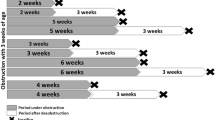Abstract
Because acute obstructive cholangitis is life-threatening, understanding of the pathophysiology of this disease is required to establish a medical treatment. Experimental results indicate that obstruction of the bile duct itself does not induce acute cholangitis, but infection of gut-derived bacteria such asEscherichia coli into the bile triggers fatal septicemia, which leads to liver injury and renal failure. In obstructive cholangitis, functional changes in sinusoidal lining cells are often seen. Mediators produced by Kupffer cells, endothelial cells, and stellate cells may modulate inflammatory reactions especially in the periportal area of bile duct ligated animals. In addition, proliferation of bile duct epithelial cells is induced by bile duct ligation. Recently, nitric oxide has been recognized as an important mediator of multiple organ failure. Actually, when bile duct ligated animals are treated with endotoxin, metabolites of nitric oxide in blood and plasma increase, indicating that nitric oxide may take part in the pathophysiology of acute obstructive cholangitis.
Similar content being viewed by others
References
Reynolds BM, Dargan EL (1959) Acute obstructive cholangitis, a distinct clinical syndrome. Ann Surg 150:299–303
Kalser MH, Block MA (1985) Cholangitis: clinical aspects and medical management. In: Berk JE, Haubrich MS, Kalser MH, Roth JLA, Schaffner F (eds) Gastroenterology, 4th edn. Saunders, Philadelphia, pp 3717–3731
Douglas TF, Shaun R, Peter HS, et al. (1957) Activation of the properdin pathway of complement in patients with gram-negative bacteremia. N Eng J Med 292:937–940
Boey JH, Way LW (1980) Acute cholangitis. Ann Surg 191:264–270
O'Connor MJ, Schwartz ML, McQuarrie DG, Sumer HW (1982) Acute bacterial cholangitis: an analysis of clinical manifestation. Arch Surg 117:437–441
Shimada K, Noro T, Inamatsu T, Urayama K, Adachi K (1981) Bacteriology of acute obstructive suppurative cholangitis of the aged. J Clin Microbiol 14:522–526
Kinoshita H, Hirohashi K, Igawa S, Nagata E, Sakai K (1984) Cholangitis. World J Surg 8:963–969
Williams RD, Fish JC, Williams DD (1967) The significance of biliary pressure. Arch Surg 95:374–379
Huang T, Bass JS, Williams RD (1969) The significance of biliary tract pressure in cholangitis. Arch Surg 95:629–632
Fleischner G. Arias IM (1970) Recent advances in bilirubin formation, transport, metabolism and excretion. Am J Med 49:576–589
Stocker R, Yamamoto Y, McDonagh AF (1987) Bilirubin is an antioxidant of possible physiological importance. Science 235:1043–1046
Inoue M, Hirata E, Morino Y, Nagase S, Chowdhury JR, Chowdhury NR, Arias IM (1985) The role of albumin in the hepatic transport of bilirubin: studies in mutant analbuminemic rats. J Biochem 97:737–743
Sugi K. Inoue M. Morino Y, Sato T (1989) Effect of obstructive jaundice on the fate of a nephrophilic organic anion in the rat. Biochem Biophys Acta 987:217–221
Hofmann A, Small D (1967) Detergent properties of bile salts: correlation with physiologic function. Ann Rev Med 18:333–376
Brouwer A, Wisse E, Knook DL (1988) Sinusoidal endothelial cells and perisinusoidal fat storing cells. In: Arias IM, Jacoby WB, Popper H, Schachter D, Shafritz DA (eds) The liver: biology and pathobiology, 2nd edn. Raven, New York, pp 665–682
Rieder H, Meyer zum Buschenferde K-H, Ramadori G (1922) Functional spectrum of sinusoidal endothelial liver cells. Filtration, endocytosis, synthetic capacities and intercellular communication. J Hepatol 15:237–250
De Bleser PJ, Braet F, Lovisetti P, Vanderkerken K, Wisse E, Geerts A (1994) Cell biology of liver endothelial cells and Kupffer cells. Gut 35:1509–1516
Wake K, Decker K, Kirn A, Knook DL, McCuskey RS, Bouwens L, Wisse E (1983) Cell biology and kinetics of Kupffer cells in the liver. Int Rev Cytol 37:531–543
Decker K (1990) Biologically active products of stimulated liver macrophages (Kupffer cells). Eur J Biochem 192:245–261
Billiar RD, Curran RD, Stuehr DJ, Stadler J, Simmons RL, Murray SA (1989) An L-arginine dependent mechanism mediates Kupffer cell inhibition of hepatocyte protein synthesis in vitro. J Exp Med 169:1467–1472
Curran RD, Billiar TR, Stuehr DJ, Hoffman RA, Simmons RL (1989) Hepatocytes produce nitrogen oxide from L-arginine in response to inflammatory products of Kupffer cells. J Exp Med 170:1769–1774
Gressner AM (1994) Perisinusoidal lipocytes and fibrogenesis. Gut 35:1331–1333
Wake K (1980) Perisinusoidal stellate cells (fat storing cell, interstitial cell, lipocyte); their related structure in and around the liver sinusoids and vitamin A storing cells in extrahepatic organs. Int Rev Cytol 166:303–353
Friedman SL (1993) The cellular basis of hepatic fibrosis. N Engl J Med 328:1828–1835
Friedman SL, Roll FJ, Boyles J, Bissell DM (1985) Hepatic lipocytes: the principal collagen-producing cells of normal rat liver. Proc Natl Acad Sci USA 82:8681–8685
Blomhoff R, Wake K (1985) Perisinusoidal stellate cells of the liver: important roles in retinol metabolism and fibrosis. FASEB J 5:271–277
Hoffmann R, Grewe M, Estler H-C, Schultz-Specking A, Decker K (1994) Regulation of tumor necrosis factor-α-mRNA synthesis and distribution of tumor necrosis factor-α-mRNA synthesizing cells in rat liver during experimental endotoxemia. J Hepatol 20:122–128
Fausto N. Liver stem cells. In: Arias IM, Boyer JL, Fausto N, Schachter D, Shafritz DA (eds) The liver: biology and pathobiology, 3rd edn. Raven, New York, pp 1501–1518
Wang Q, Jacobs J, DeLeo J, Kruszyna R, Smith R, Wilcox D (1991) Nitric oxide hemoglobin in mice and rats endotoxin shock. Life Sci 49:PL55–60
Author information
Authors and Affiliations
About this article
Cite this article
Kawada, N., Takemura, S., Minamiyama, Y. et al. Pathophysiology of acute obstructive cholangitis. J Hep Bil Pancr Surg 3, 4–8 (1996). https://doi.org/10.1007/BF01212771
Received:
Accepted:
Issue Date:
DOI: https://doi.org/10.1007/BF01212771




